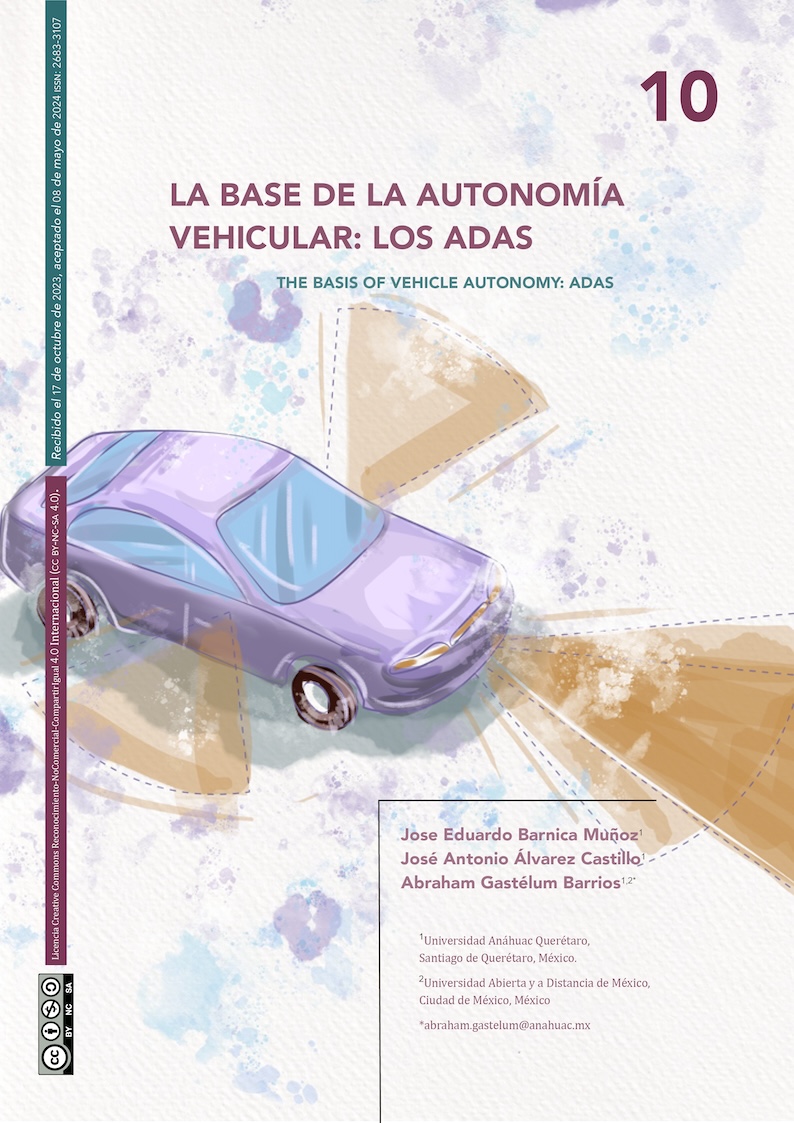Abstract
ADAS systems comprise a branch of innovation and development within the automotive industry that has allowed vehicle evolution in technological aspects that were not available before. The need to ensure the integrity of people while driving has generated automotive modernization aimed at autonomous vehicles. Generating intelligent systems based on sensors, cameras and radars allows the processing of information in real time for decision making. By implementing multiple technologies that help the driver have a better and safer driving experience, ADAS has begun to be mandatory for the manufacture of new vehicles. The future points to a massive revolution where large investments are expected in the industry from which important advances will be obtained that will be reflected in the cutting-edge technology implemented in the new models of the main commercial brands. This article focuses on highlighting the regulatory, instrumentation and opportunity trends for the development of ADAS systems for automobiles.
References
S. Peiris, S. Newstead, J. Berecki-Gisolf, B. Chen, and B. Fildes, “Quantifying the Lost Safety Benefits of ADAS Technologies Due to Inadequate Supporting Road Infrastructure,” Sustainability (Switzerland), vol. 14, no. 4, Feb. 2022, doi: 10.3390/su14042234.
Den, “Sistemas ADAS: qué son y cuáles tenemos en nuestros coches,” https://club.autodoc.es/magazin/sistemas-adas-que-son.
K. Hojjati-Emami, B. S. Dhillon, and K. Jenab, “Reliability prediction for the vehicles equipped with advanced driver assistance systems (ADAS) and passive safety systems (PSS),” International Journal of Industrial Engineering Computations, vol. 3, no. 5, pp. 731–742, 2012, doi: 10.5267/j.ijiec.2012.08.004.
William Kelley, “US4926171A_Original_document_20230329211909,” https://worldwide.espacenet.com/patent/search/family/023045982/publication/US4926171A?q=pn%3DUS4926171.
A. Ziebinski, R. Cupek, D. Grzechca, and L. Chruszczyk, “Review of advanced driver assistance systems (ADAS),” in AIP Conference Proceedings, American Institute of Physics Inc., Nov. 2017. doi: 10.1063/1.5012394.
Fundación MAPFRE Canarias, “¿Qué son los Sistemas ADAS?,” https://www.fundacionmapfre.org/educacion-divulgacion/seguridad-vial/sistemas-adas/que-son-los-sistemas-adas/.
Badr Ben Elallid, Nabil Benamar, Abdelhakim Hafid, Tajjeeddine Rachidi, Nabil Mrani, “A Comprehensive Survey on the Application of Deep and Reinforcement Learning Approaches in Autonomous Driving,” 2022. doi: 10.1016/j.jksuci.2022.03.013.
P. di Torino and S. Ballesio, “Artificial Intelligence Controls for Vehicle Emergency Maneuvering,” 2020. [Online]. Available: https://api.semanticscholar.org/CorpusID:236911951
Expansión, “Un choque de un Tesla, aparentemente sin conductor deja dos personas fallecidas,” https://expansion.mx/tecnologia/2021/04/18/choque-tesla-dos-personas-fallecidas.
Rubén Fidalgo, “8 ADAS obligatorias en los coches desde julio de 2022,” https://www.autocasion.com/actualidad/reportajes/8-adas-oblitatorias-en-los-coches-a-partir-de-julio-de-2022.
Eduardo Montemayor, “NORMA Oficial Mexicana NOM-194-SE-2021, Dispositivos de seguridad para vehículos ligeros nuevos-Requisitos y especificaciones,” https://www.dof.gob.mx/nota_detalle.php?codigo=5666804&fecha=03/10/2022#gsc.tab=0
Zamarrón, “Así operan los semáforos inteligentes en la capital,” https://www.elsoldemexico.com.mx/metropoli/cdmx/asi-operan-los-semaforos-inteligentes-en-la-capital-3287849.html.
Cantera, “¿Buscas estaciones de recarga para autos eléctricos?,” https://www.eluniversal.com.mx/cartera/buscas-estaciones-de-recarga-para-autos-electricos-google-maps-te-dice-donde/.
Maya, “Estas son las ciudades con cobertura Telcel 5G,” https://expansion.mx/tecnologia/2022/02/22/cobertura-telcel-5g-mexico.
Instituto Mexicano del Transporte, “Representación cartográfica en formato digital y georreferenciada de la red nacional de caminos,” https://www.gob.mx/imt/acciones-y-programas/red-nacional-de-caminos.
García, “México produciría 193 mil vehículos eléctricos al cierre de 2023,” https://www.clusterindustrial.com.mx/noticia/6697/mexico-produciria-193-mil-vehiculos-electricos-al-cierre-de-2023-directorio-automotriz.
Statista Research Department, “Número de vehículos eléctricos e híbridos vendidos en México desde 2016 a 2022,” https://es.statista.com/estadisticas/1114981/volumen-ventas-vehiculos-electricos-hibridos-mexico/#:~:text=El%20n%C3%BAmero%20de%20veh%C3%ADculos%20el%C3%A9ctricos%20e%20h%C3%ADbridos%20vendidos,de%20este%20tipo%20de%20autom%C3%B3viles%20registrado%20en%202021.
S. Ortiz, “Tesla is changing the sensors in its cars. Here is why you should care,” https://www.zdnet.com/article/tesla-removed-its-ultrasonic-sensors-from-its-cars-what-does-that-mean-for-your-tesla-vehicle-your-safety-and-teslas-future.
C. Thompson, “There’s one big difference between Google and Tesla’s self-driving car technology,” https://www.businessinsider.com/difference-between-google-and-tesla-driverless-cars-201512?r=MX&IR=T.
Waymo, “How our cars drive,” https://support.google.com/waymo/answer/9190838?hl=en.
Comunicación de prensa Audi, “Jornadas Técnicas conducción pilotada,” http://prensa.audi.es/wp-content/uploads/2017/09/Dossier-A8-AI-traffic-jam-plilot.pdf.
J. L. Omeñaca, “Los ADAS alcanzarán los 83 mil millones de dólares para 2030,” https://valenciacars.blogspot.com/2020/06/2030-adas-alcanzaran-83-mil-millones-dolares.html.
Iiona Scully, Sean Scally, Ryan Clark, “safety and Regulatory Considerations of Advanced Driver Assitancce Systems (ADAS),” https://www.americanbar.org/groups/tort_trial_insurance_practice/committees/automobile-litigation/safety_regulatory_considerations/.
Zamarrón, “Nearshoring en México: estos son los beneficios que podría obtener el país a 2030,” https://www.forbes.com.mx/nearshoring-en-mexico-estos-son-los-beneficios-que-podria-obtener-el-pais-a-2030/.
Gobierno de México, “La Inversión Extranjera Directa en México sumó 31.6 mil millones de dólares en 2021,” https://www.gob.mx/shcp/gacetaeconomica/articulos/la-inversion-extranjera-directa-en-mexico-sumo-31-6-mil-mdd-en-2021.
W. Bernhart and M. Winterhoff, “Autonomous Driving: Disruptive Innovation that Promises to Change the Automotive Industry as We Know It,” 2016, pp. 3–10. doi: 10.1007/978-3-319-19818-7_1.
ADAS system regulations, “ADAS system regulations,” https://www.fundacionmapfre.org/en/education-outreach/road-safety/adas-systems/what-are-adas-systems/adas-systems-regulations/.

This work is licensed under a Creative Commons Attribution-NonCommercial-ShareAlike 4.0 International License.
Copyright (c) 2024 Perspectivas de la Ciencia y la Tecnología

